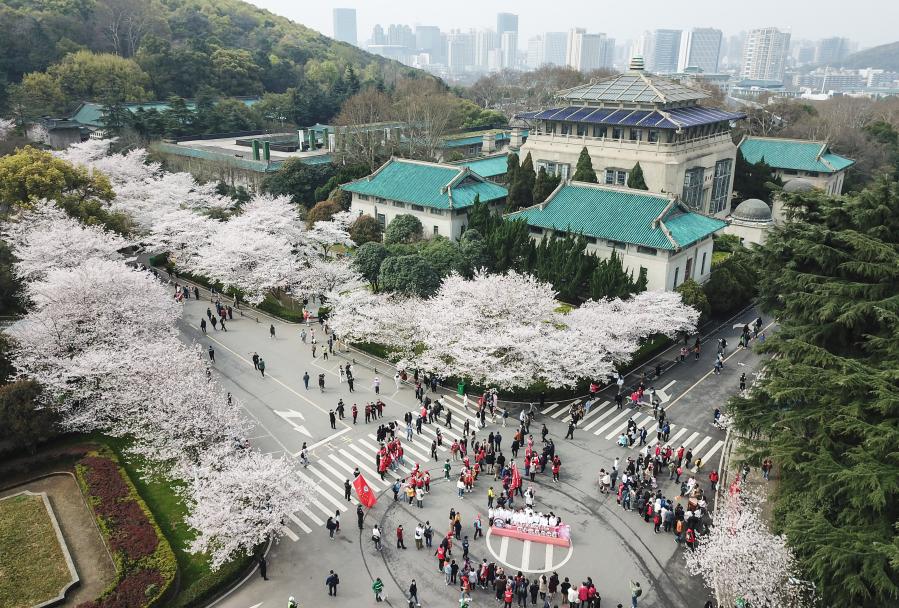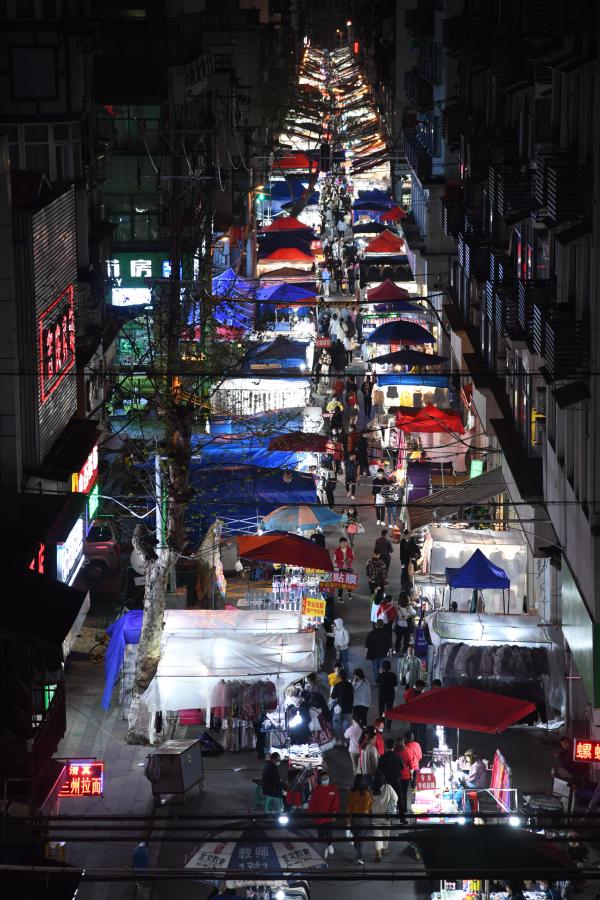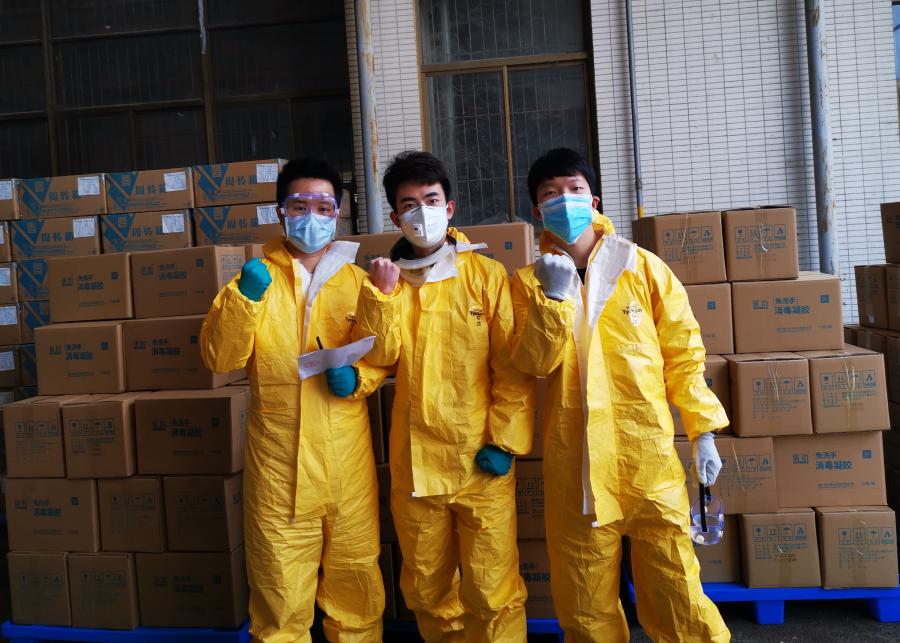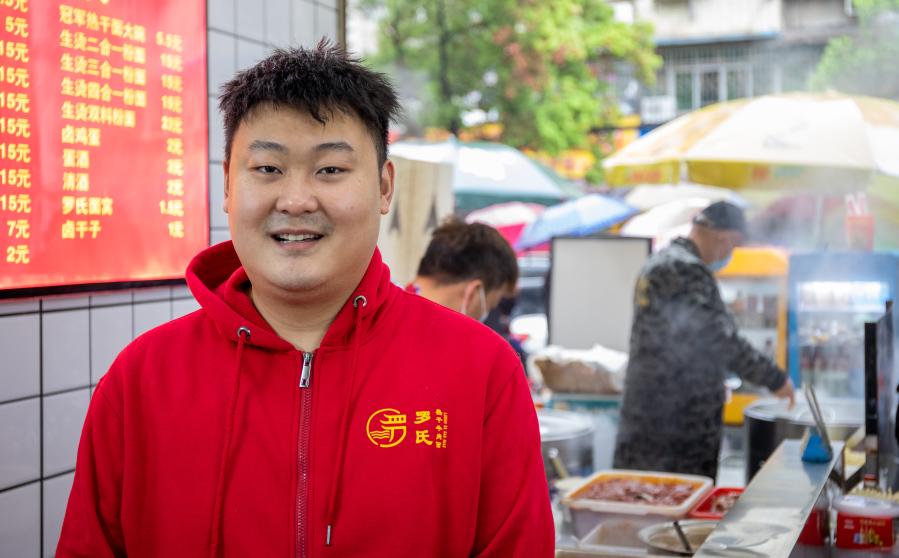Happy rebirth-day: Wuhan marks one year of recovery since COVID-19 lockdown ends
-- The megacity of Wuhan on Thursday marked the first anniversary since it ended the 76-day isolation and the 10th month without reporting any locally transmitted infections.
-- Strict quarantines during the lockdown, a citywide nucleic acid testing drive and regular anti-virus measures have contributed to Wuhan's rise as a post-pandemic "city of safety." An ongoing inoculation drive is expected to further beef up the city's defense against the virus.
-- Residents, flight crew and even hot dry noodle shops have testified to the return of economic and social vitality and the end of the "psychological lockdown."

Medical workers who had assisted with the fight against the epidemic in 2020 enjoy the cherry blossom season at Wuhan University in central China's Hubei Province, March 13, 2021. (Xinhua/Cheng Min)
Wuhan resident Yuan Baohua carried a sense of responsibility with her when going for the COVID-19 inoculation, which she believed will help boost the city's collective immunity a year after a COVID-19 lockdown was lifted.
"Though I'm old, I'm in good health, and many of my peers have already taken the vaccine," Yuan said while getting the first of two doses after the city expanded COVID-19 inoculation to include elderly residents in late March.
Accompanying her at the vaccination site was her daughter-in-law Celia Esquivel Salguero, who has lived in Wuhan for over 10 years. "I told my parents in Guatemala about my decision to take the vaccine, and they fully supported me," she said.
Yuan's family has faithfully participated in Wuhan's previous mass mobilization that helped the city triumph over the virus, from months-long home quarantines to citywide nucleic acid testing.
"Now the vaccination will add more defense, and I'm looking forward to the day when we are no longer afraid of the virus," Yuan said.

Photo taken on March 29, 2021 shows a night market in Wuhan, central China's Hubei Province. (Xinhua/Cheng Min)
City of safety
On Thursday, the megacity in central China's Hubei Province marked the first anniversary since it ended the 76-day isolation and the 10th month without reporting any locally transmitted infections.
Strict quarantines during the lockdown, the citywide nucleic acid testing drive that tested nearly 10 million residents and enforcement of regular anti-virus measures have made Wuhan a post-pandemic "city of safety" and lifted its "psychological lockdown."
Shopping blocks, pedestrian streets and restaurants in the city are again crowded with people. Li Li queued for nearly two hours on the popular Hanjie Street to taste this year's crayfish.
The 26-year-old local resident was comfortable with dining out in a restaurant packed with people. "Why not? I think we are in one of the safest cities in the world," she said.
Wuhan has reported no new local infections since May 18, 2020. As of Tuesday, nearly 3.7 million doses of COVID-19 vaccines have been administered in Wuhan, according to the municipal health commission.

People visit a commercial street in Wuhan, central China's Hubei Province, March 28, 2021. (Xinhua/Cheng Min)
About 2 km from Hanjie Street stands the Zhongnan Hospital of Wuhan University, one of the first hospitals in Wuhan designated to treat COVID-19 patients and also among the last to resume normal operation.
Zhang Dongdong, a physiotherapist at the hospital, saw the return of his patients as evidence that the city is back on its feet.
"At first, many patients would not dare come for rehab, as our ward had been used to receive COVID-19 patients, but by last September, our department was once again filled with people," the therapist said.
"My job is to help patients gradually stand up, walk and run through physical training, just as Wuhan recovered with help from across the country," Zhang said.
To defend the victory against the novel coronavirus, Wuhan has been empowering its public health sector since last year. It has built four 1,000-member teams to conduct epidemiological investigations, disinfection, testing and epidemic control respectively.
"I barely had a break at the peak of Wuhan's epidemic. During the day, I was busy with epidemiological investigations, and I had to collect and report related information at night," recalled Tan Yefeng, a doctor at Wuchang district's center for disease control and prevention (CDC).
Epidemiological investigations track the routes and sources of new infections, which is vital for official interventions to contain any further spread.
Tan testified to the substantial improvements in the epidemic response system, including the expansion of the district CDC personnel, whose number has doubled since the outbreak and will continue to increase.
"And now not only the CDC but also personnel from hospitals, civil service, police and communities will join epidemiological investigations," he said.

Zhai Chenfei (C), a pilot of China Southern Airlines, poses with volunteers during his work break in Wuhan, central China's Hubei Province, Feb. 22, 2020. (Xinhua)
Economy recovery
During Wuhan's lockdown that saw outbound flights and trains suspended, Zhai Chenfei, a pilot with China Southern Airlines, piloted his car instead of a plane to help deliver vegetables and medicine for residents and medical workers.
It was not until September that Zhai was able to be back in the cockpit.
"Flying through the blue sky made me feel my life had finally returned to the right track," said Zhai. "Though the number of flights and passengers remained sluggish for a long time, I can see the industry pick up steam these days."
According to the operator of the Wuhan Tianhe International Airport, the airport handled a daily average of 536 domestic passenger flights and 65,800 domestic passengers in March, up 14.03 percent and 4.99 percent respectively from the same period in 2019.
As the Chinese city hit hardest by the virus, Wuhan's GDP dropped by a moderately 4.7 percent in 2020, compared with a 40.5-percent contraction in the virus-ravaged first quarter. The investments it received last year even rose 6.7 percent to 930 billion yuan (142 billion U.S. dollars).
The uptrend continued this year, with 215 large projects worth 330.54 billion yuan launched in February, and 112 projects inked with a total investment of 346.2 billion yuan in March. Both hit record highs in Wuhan.
The service sector is also in steady recovery. Running a shop selling Wuhan's signature hot dry noodles, Luo Sisi now gets up at 3 a.m. to prepare the food as customers return in large numbers.
"Our sales are even 10 percent higher than that in the year 2019," said Luo.

Photo taken on April 2, 2021 shows Luo Sisi at his hot dry noodles shop in Wuhan, central China's Hubei Province. (Xinhua/Rao Rao)
Reopened on April 15, 2020, Luo's noodles shop also witnessed the city's psychological recovery. He felt relieved, especially when seeing parents taking their children out to eat breakfast.
"People are more tolerant after the epidemic. Everyone is more patient when queuing up to buy noodles, and everything is more orderly," said Luo.
Luo's parent shop operates over 70 branch stores. Although a dozen closed during the epidemic, 27 new shops opened after June 2020.
"The hot dry noodle is not only a popular food but also a spiritual icon of the city," Luo said. "We have not only survived the epidemic, but are now capable of helping more people start a business."